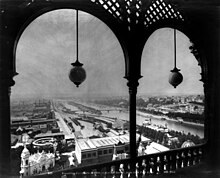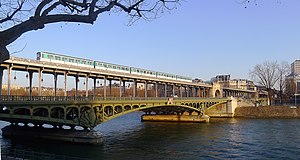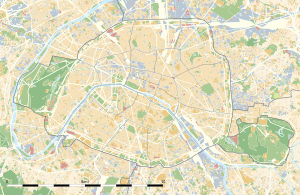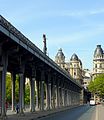Pont de Bir-Hakeim
Coordinates: 48 ° 51 ′ 20 ″ N , 2 ° 17 ′ 16 ″ E
| Pont de Bir-Hakeim | ||
|---|---|---|
| Pont de Bir-Hakeim (south side) with Metro train of the line 6 on the Viaduct Passy | ||
| Convicted | La Seine | |
| place | Paris | |
| Building number | 0988 | |
| construction | Arch Bridge from steel | |
| overall length | 237 | |
| width | 24.7 | |
| start of building | 1903 | |
| completion | 1905 | |
| planner |
J.-C. Formigé L. Biette Daydé & Pillé |
|
| location | ||
|
|
||
The Pont de Bir-Hakeim is a bridge over the Seine in Paris . It was built in 1878 as the Pont de Passy . In 1949 it was given its current name, on July 10, 1986 it was declared a monument worthy of protection.
location
The bridge connects the avenue du Président-Kennedy in the Quartier de la Muette of the 16th arrondissement over the Seine with its left bank ( Quai Branly and Quai de Grenelle ) in a north-west-south-east direction .
The Métroviaduct Viaduc de Passy crosses the river on the bridge , it is located between the stations Passy on the right bank and Bir-Hakeim on the left bank of the Seine. Between the ends of the two stations it is a total of 380 m long; it is used by underground trains on line 6 .
Because of the good view of the Eiffel Tower , the Pont de Bir-Hakeim is visited by numerous onlookers during major events such as fireworks.
Pont de Bir-Hakeim and Ile aux Cygnes from the Eiffel Tower seen from
Rubber-tired train on the viaduct, in the background the Passy metro station
history

The bridge is level with the northeastern tip of the artificial island Île aux Cygnes , a dam built in 1825 that divides the Seine. A first footbridge, which connected the two banks there, was built in 1878. The iron structure was opened on the occasion of the World Exhibition of 1878 and was named Passerelle de Passy .
Between May 1903 and April 1906, a road bridge was built in its place as the Pont de Passy . In the center thereof along a was elevated railway - viaduct the metro ( "Viaduct Passy") is applied below which a 8.70 m wide was walkway, which now as a bike path is used. In order to allow pedestrians to cross the river during construction, the footbridge was moved 30 m downstream.
The architect of the bridge was Louis Biette ; The construction was carried out by the then engineering office Daydé & Pillé .
The viaduct of the elevated railway was opened on April 24, 1906 and initially belonged to metro line 2 Sud. In 1907, the route was assigned to line 5 (then Étoile - Gare du Nord ), and finally to line 6 in 1942. Rubber-tired trains have been running since July 1974 .
Section over the wider arm with the Sprague-Thomson type metro train (1972)
Surname

The original name of the bridge was Pont de Passy . Passy was an independent municipality until 1859 and is now part of the 16th arrondissement of Paris on the right bank of the Seine, which is also known as the Arrondissement Passy .
In 1949, the bridge was renamed after the Battle of Bir Hakeim in World War II , during which a brigade of Free French troops held up the Wehrmacht's advance for more than two weeks.
description
Strictly speaking, the road bridge consists of two parts that come together on the artificial island from the banks. The section over the broader arm of the river from the right bank is 114 m long, that over the narrower arm on the left bank is 90 m. The part in between on the Île aux Cygnes has a length of 23.50 m. The bridge is a total of 24.70 m wide; the width of the two lanes is 6 m each, that of the two sidewalks is 2 m each. The iron construction rests on two masonry bases per river arm and abutments on the four banks. In the middle of the island there are 12 m long cantilevers . The pillars are adorned with cast-iron groups of figures by the sculptor Gustave Michel depicting sailors and blacksmiths.
The Métro viaduct rests on 19 (wide river arm) and 15 (narrow arm) pairs of iron piers, which were reinforced in 1942. On the island, it runs over a brick arch in the form of a gate designed by the architect Jean Camille Formigé . The latter bears four figures by Jules Coutan and Jean-Antoine Injalbert in bas-relief . At the level of the arch, a wide staircase leads down from the southwest pavement to the Île aux Cygnes.
The bridge offers several characteristics:
- 12 m in the middle is built with cantilever beams .
- There are two floors: one for pedestrians and cars and one as a viaduct for Métroline 6 .
- The Métro viaduct rests above the water on metal piles and on the Île aux Cygnes on brick arches.
- The metro bridge runs horizontally, while the road bridge slopes down from the left bank to the right bank.
- The footpath under the viaduct was replaced by a bicycle path around 2010 .
- In the middle is a staircase that allows a walk from Île aux Cygnes to the Pont de Grenelle and the Statue of Liberty .
The bridge is adorned with four monumental stone statues in bas- relief, located on the central arch of the viaduct on the Île aux Cygnes:
- La Science et Le Travail ( German science and work ) by Jules Coutan upstream
- L'Électricité et Le Commerce ( German electricity and trade ) by Jean-Antoine Injalbert downstream
The pillars are adorned with two groups of statues by Gustave Michel, tightly woven into the frame : Les Nautes , equipped with maritime accessories (net, buoy, sails, etc.), which affix the coat of arms of the city of Paris to the pillar and Les Forgerons-riveteurs , the place an RF emblem on the pillar. These groups are reproduced identically on the two arms of the Seine, upstream and downstream (i.e. four reproductions of each group).
Others
The plot of the film The Last Tango in Paris begins on the promenade under the Métro viaduct . Scenes from the film Inception were also shot at the bridge.
See also
Other bridges with an underground viaduct above street level are the upstream Pont de Bercy and the Berlin Oberbaum Bridge .
Web links
literature
- Jean Tricoire: Un siècle de métro en 14 lignes. De Bienvenüe à Météor . 2nd Edition. La Vie du Rail, Paris 2000, ISBN 2-902808-87-9 , p. 206 ff .
Individual evidence
- ↑ PA00086658 , Base Mérimée , Ministry of Culture (France)
- ↑ Pont de Bir-Hakeim at histoire-en-ligne.com, accessed on April 4, 2015
- ^ Jean Tricoire: Préambule . In: Le Train spécial . Paris et l'Île-de-Françe, No. 37 , 2004, p. 6 .
- ↑ a b Viaduc de Passy at culture.gouv.fr, accessed on April 3, 2015
- ^ French: Daydé & Pillé
- ↑ a b Jean Tricoire: Un siècle de métro en 14 lignes. De Bienvenüe à Météor . 2nd Edition. La Vie du Rail, Paris 2000, ISBN 2-902808-87-9 , p. 208 .













